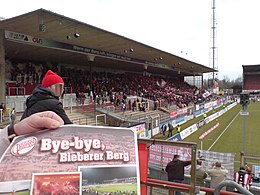Stadium on the Bieberer Berg
| Stadium on the Bieberer Berg | |
|---|---|

|
|
| Data | |
| place |
|
| Coordinates | 50 ° 5 '40 " N , 8 ° 47' 55" E |
| opening | May 21, 1921 |
| demolition | 2011/2012 |
| surface | Natural grass |
| capacity | 25,000 |
| Societies) | |
The stadium on Bieberer Berg in Offenbach am Main was purely a football stadium and was located on the hill of the same name between Offenbach and the Bieber district on Bieberer Straße . The Kickers Offenbach team played in this stadium .
It was demolished between February 2011 and 2012 in order to build the Sparda Bank Hessen Stadium on the same site .
history
The stadium on Bieberer Berg (in dialect : Bieberä Bärsch with a very short “ä” in the word 'Bärsch') was opened on May 21, 1921. The wooden main grandstand then held 1200 spectators. In 1952 a covered standing grandstand was completed opposite the main stand. The first floodlight system with four masts was inaugurated in 1956 and dismantled again in 1959. The main grandstand was rebuilt in 1960, followed in 1968 by the tubular steel grandstand and a floodlight system, which consisted of only two light masts . In 1973 the southeast stand (since April 1, 2007: "Henninger stand") was built. After a club crisis in 1991, the city of Offenbach am Main considered selling or demolishing the stadium. These plans were discarded and the stadium was given to Offenbacher Fußballclub Kickers 1901 e. V. handed over in long lease in 1992 . The defective roof of the main stand was renovated in 1993 with the money from the Rettet den Bieberer Berg donation campaign . In 1997 a billboard was set up, but it was only in operation for a short time - in 1999 - and was only functional for a single game. In 1998, Block 2 of the standing grandstand was expanded.
As part of a special investment program “Sportland Hessen 2005–2007”, the State of Hesse provided 1.2 million euros for the renovation of the stadium, which was urgently needed due to the promotion to the 2nd Bundesliga. During the summer break of the 2006/07 season, the stadium was given a new lawn and heated floor. At the beginning of the 2007/08 season, a new cabin wing for the home and visiting teams and the referees was completed under the Henninger grandstand.
Capacity
The stadium on Bieberer Berg had a capacity of 25,000 after the renovation and renovation work carried out in summer 2005. These were distributed as follows:
- Main grandstand with 3,500 covered seats (including 240 business seats)
- Southeast stand with 3,000 covered seats
- Waldemar Klein grandstand with blocks 1, 2a / b and 3 with 10,000 covered standing room
- East curve with 2,500 uncovered standing places below the southeast stand
- Tubular steel grandstand including west curve with 6,000 uncovered standing places
The attendance record was set on September 19, 1968 at the game Kickers Offenbach against TSV 1860 Munich with 33,000 spectators. Kickers Offenbach lost 2: 3.
New stadium

Plans through 2008
In May 2006 plans for a partial renovation of the stadium were presented: Instead of the tubular steel grandstand, a business hotel with 159 rooms was to be built, 60 of which would have offered a direct view of the stadium.
A new grandstand with around 1,800 seats would have been integrated into the hotel. The investments for the entire project amounting to 19.4 million euros should have been financed entirely privately. Since no investors could be found for the project, the project was abandoned in summer 2007.
Instead, the OFC under the direction of Thomas Delhougne envisaged a completely new stadium. The design by the Geiseler Gergull architecture firm envisaged a 29,300-seat two-tier stadium on the training grounds north of the existing stadium. The construction costs including all infrastructure measures would have amounted to around 40 million euros. After the OFC was relegated from the 2nd Bundesliga in summer 2008, the plans were dropped again.
Sparda Bank Hessen Stadium from 2011
On June 18, 2009, the Offenbach municipal authorities made a fundamental decision on a new building costing 25 million euros. The client is the newly founded stadium company Bieberer Berg as a subsidiary of Stadtwerke Offenbach Holding (SOH for short), which rents the stadium for 450,000 euros annually to OFC, which has outsourced its professional department to a corporation.
The new Sparda Bank Hessen Stadium , a one-tier stadium in the “English style” with four individual stands, was built by Bremer AG from Paderborn at the location of the old stadium. Demolition work began in February 2011. The stadium, with a capacity of around 20,500 (10,300 seats and 10,200 standing), was reopened on July 18, 2012.
The naming rights were sold to Sparda-Bank Hessen in December 2009 for five million euros . The contract runs for ten years.
See also
Web links
- Official website of the Sparda-Bank-Hessen-Stadium on Bieberer Berg
- The Sparda-Bank-Hessen-Stadion am Bieberer Berg on the official website of Kickers Offenbach
- Interest group Stadionbau e. V. (IGS) represents the interests of fans in the new stadium in Offenbach
Individual evidence
- ↑ Jörg Muthorst: New stadium in the English style. In: fr-online.de . January 12, 2011, accessed July 7, 2016 .
- ↑ The new Sparda-Bank Hessen Stadium - space for 20,500 spectators. Offenbacher Kickers 1901 GmbH, January 12, 2011, archived from the original on March 24, 2011 ; Retrieved July 7, 2016 .
- ↑ OFC sells stadium names. In: ntv.de . December 15, 2009, accessed July 7, 2016 .


